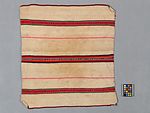Cloth
About this object
History of use
Warp-faced fabrics with three or four selvedges are woven by women on the indigenous style loom, a staked-out horizontal ground loom, or an adjustable tension (body) loom. The technique and structure have pre-Conquest antecedents, and as in ancient times, the fabrics are used in their rectangular form without cutting or shaping. This style of unkuna is an all-purpose carrying cloth, frequently used for carrying a midday meal of boiled potatoes and dried fish. Men and women use unkunas for carrying smaller things in a hand bundle. Young girls sometimes use unkunas for carrying things on their backs.
Narrative
Woven and used by Silvia Yucra Huatta, a young married woman related by marriage to the family from whom most of the Taquile collection came. She is a sister of Gonzalo Yucra Huatta.
Cultural context
carrying cloth
Specific techniques
Plain colour areas or stripes are warp-faced plain weave. The weave structure of the 3 stripes with squares is a float weave derived from a turned 2/1 horizontal herringbone with floats forming squares.
Physical description
Cloth, rectangular, made of off-white woven wool with three multicoloured bands with a thin central band of white squares and repeated short stripes. Narrow bright pink stripes separate the bands. Two opposite selvedges are edged with black and red stripes.
Categories
Materials
